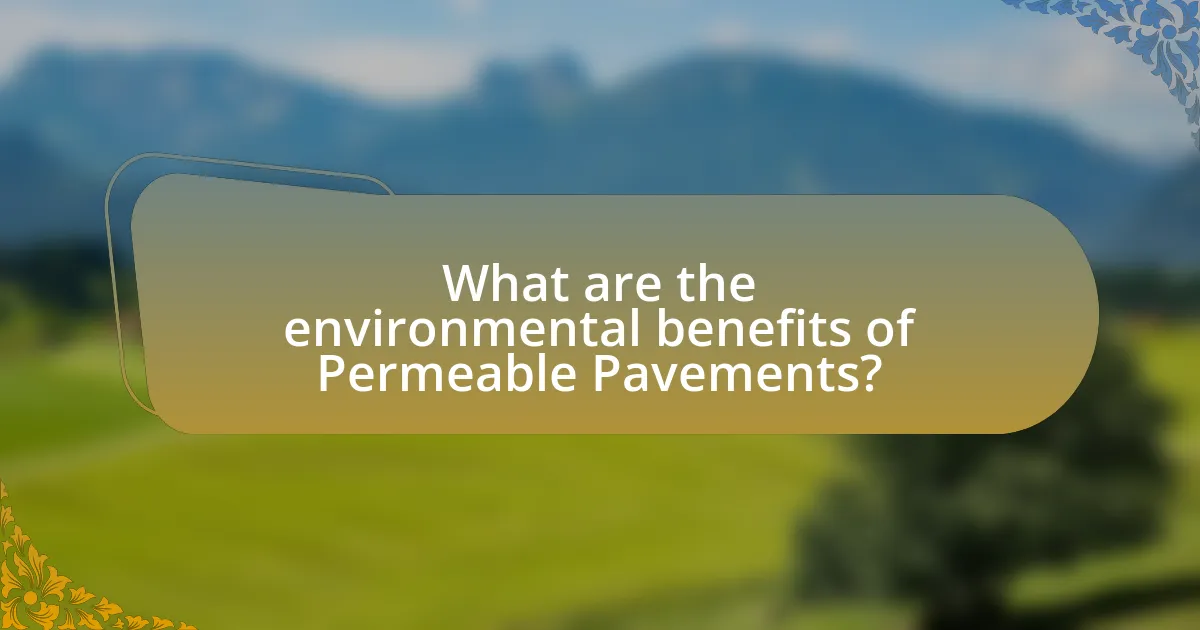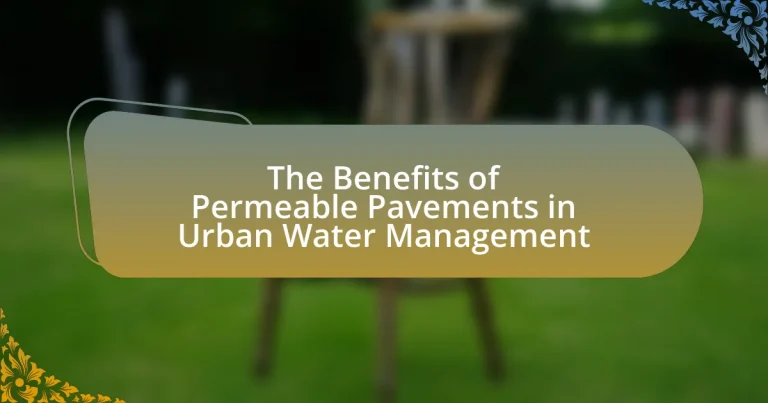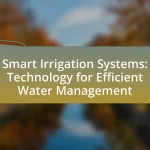Permeable pavements are innovative surface materials designed to facilitate water infiltration, thereby managing stormwater effectively in urban environments. This article explores the functionality of permeable pavements, detailing their construction materials, mechanisms of water infiltration, and their significant role in reducing urban flooding and promoting groundwater recharge. Additionally, it highlights the environmental benefits, including improved water quality and urban heat management, as well as the economic advantages associated with their implementation. The article also addresses challenges related to installation and maintenance, while providing insights into best practices and future trends in permeable pavement technology.

What are Permeable Pavements?
Permeable pavements are a type of surface material designed to allow water to infiltrate through the pavement and into the underlying soil. This innovative approach helps manage stormwater by reducing runoff and promoting groundwater recharge. Studies indicate that permeable pavements can significantly decrease surface water flooding and improve water quality by filtering pollutants as water passes through the material.
How do Permeable Pavements function in urban environments?
Permeable pavements function in urban environments by allowing water to infiltrate through their surface, reducing runoff and promoting groundwater recharge. These pavements are designed with materials that create voids or pores, enabling rainwater to pass through and be absorbed into the underlying soil. This process mitigates flooding, decreases the burden on stormwater systems, and improves water quality by filtering pollutants as water percolates through the pavement structure. Studies have shown that permeable pavements can significantly lower surface temperatures and enhance urban biodiversity, making them a valuable tool in sustainable urban water management.
What materials are used in the construction of Permeable Pavements?
Permeable pavements are constructed using materials such as porous asphalt, permeable concrete, and interlocking concrete pavers. These materials are specifically designed to allow water to infiltrate through the surface, reducing runoff and promoting groundwater recharge. Porous asphalt consists of a mixture of asphalt and aggregate that creates voids for water passage, while permeable concrete uses a similar approach with larger aggregates and fewer fine particles to enhance permeability. Interlocking concrete pavers are designed with gaps that facilitate water flow through the joints. These materials collectively contribute to effective urban water management by mitigating flooding and improving water quality.
How does water infiltration occur through Permeable Pavements?
Water infiltration through permeable pavements occurs when rainwater or surface runoff seeps through the porous surface and into the underlying layers. This process is facilitated by the design of permeable pavements, which typically consist of materials like porous asphalt, permeable concrete, or interlocking pavers that allow water to pass through.
The infiltration process begins as water collects on the pavement surface, where it then flows into the voids created by the pavement’s structure. Once the water reaches the sub-base layer, it continues to infiltrate into the soil below, promoting groundwater recharge and reducing surface runoff. Studies have shown that permeable pavements can significantly decrease the volume of stormwater runoff, with some systems capable of managing up to 90% of rainfall events effectively.
Why are Permeable Pavements important for urban water management?
Permeable pavements are important for urban water management because they allow water to infiltrate through the surface, reducing runoff and promoting groundwater recharge. This infiltration helps mitigate flooding by decreasing the volume of stormwater that enters drainage systems, which can become overwhelmed during heavy rainfall. Studies indicate that permeable pavements can reduce surface runoff by up to 80%, significantly lowering the risk of urban flooding and water pollution. Additionally, they filter pollutants from stormwater, improving water quality before it reaches natural water bodies.
What role do Permeable Pavements play in reducing urban flooding?
Permeable pavements play a crucial role in reducing urban flooding by allowing water to infiltrate through the surface, thereby decreasing surface runoff. This infiltration process helps to manage stormwater effectively, reducing the volume of water that can overwhelm drainage systems during heavy rainfall. Studies indicate that permeable pavements can reduce runoff by up to 50% compared to traditional impermeable surfaces, significantly mitigating the risk of urban flooding.
How do Permeable Pavements contribute to groundwater recharge?
Permeable pavements contribute to groundwater recharge by allowing rainwater and surface runoff to infiltrate through their porous surfaces into the underlying soil and aquifers. This infiltration process reduces surface runoff, which can lead to flooding and erosion, while simultaneously replenishing groundwater supplies. Studies indicate that permeable pavements can increase groundwater recharge rates by 50% or more compared to traditional impervious surfaces, as they facilitate the natural hydrological cycle by promoting water absorption and filtration.

What are the environmental benefits of Permeable Pavements?
Permeable pavements provide significant environmental benefits by facilitating stormwater management and reducing urban runoff. These pavements allow water to infiltrate through the surface, which helps recharge groundwater supplies and minimizes the risk of flooding. According to a study by the U.S. Environmental Protection Agency, permeable pavements can reduce runoff by up to 80% compared to traditional impervious surfaces. Additionally, they help filter pollutants from stormwater, improving water quality in nearby bodies of water. This filtration process can remove up to 90% of sediment and other contaminants, contributing to healthier ecosystems.
How do Permeable Pavements improve water quality?
Permeable pavements improve water quality by allowing rainwater to infiltrate through the surface, reducing runoff and filtering pollutants. This infiltration process helps to remove contaminants such as heavy metals, oils, and sediments before they reach stormwater systems or natural water bodies. Studies have shown that permeable pavements can reduce the concentration of pollutants by up to 90%, effectively enhancing the quality of water that recharges groundwater supplies.
What pollutants can be filtered by Permeable Pavements?
Permeable pavements can filter various pollutants, including heavy metals, sediments, nutrients, and hydrocarbons. Studies have shown that permeable pavements effectively reduce concentrations of pollutants such as zinc, copper, and lead, which are commonly found in urban runoff. For instance, research indicates that permeable pavements can remove up to 90% of total suspended solids and significantly reduce nutrient loads, such as nitrogen and phosphorus, thereby improving water quality in urban environments.
How does the design of Permeable Pavements enhance ecological health?
The design of permeable pavements enhances ecological health by facilitating natural water infiltration and reducing surface runoff. This allows rainwater to percolate through the pavement, replenishing groundwater supplies and minimizing the risk of flooding. Additionally, permeable pavements filter pollutants from stormwater, improving water quality as it re-enters the ecosystem. Studies have shown that areas with permeable pavements experience increased biodiversity, as these surfaces support vegetation growth and provide habitats for various organisms. For instance, research published in the journal “Environmental Management” highlights that permeable pavements can significantly reduce urban heat islands and promote healthier urban ecosystems.
What are the benefits of Permeable Pavements for urban heat management?
Permeable pavements significantly reduce urban heat by allowing water to infiltrate and evaporate, which cools the surrounding environment. This cooling effect occurs because the evaporation process absorbs heat, thereby lowering surface temperatures. Studies indicate that permeable pavements can reduce surface temperatures by up to 10 degrees Fahrenheit compared to traditional impervious surfaces. Additionally, they help mitigate the urban heat island effect, where urban areas experience higher temperatures than their rural surroundings due to human activities and infrastructure. By promoting water infiltration and reducing runoff, permeable pavements contribute to improved thermal comfort in urban settings.
How do Permeable Pavements affect urban temperatures?
Permeable pavements reduce urban temperatures by allowing water to infiltrate through the surface, which mitigates heat buildup. This infiltration process promotes evaporation and cooling, leading to lower surface and ambient temperatures in urban areas. Studies have shown that permeable pavements can decrease surface temperatures by up to 10 degrees Fahrenheit compared to traditional impervious surfaces, thereby contributing to the urban heat island effect reduction.
What is the impact of Permeable Pavements on urban air quality?
Permeable pavements positively impact urban air quality by reducing surface runoff and promoting groundwater recharge, which helps mitigate urban heat islands. This reduction in heat can lower the formation of ground-level ozone, a significant air pollutant. Studies indicate that permeable pavements can decrease the temperature of urban surfaces, leading to improved air quality. For instance, research published in the journal “Environmental Science & Technology” demonstrates that permeable pavements can reduce ambient temperatures by up to 5 degrees Celsius, thereby contributing to lower ozone levels and enhancing overall air quality in urban environments.

What are the economic advantages of implementing Permeable Pavements?
Implementing permeable pavements offers significant economic advantages, primarily through reduced stormwater management costs. By allowing water to infiltrate through the pavement, municipalities can decrease the need for expensive drainage systems and reduce the risk of flooding, which can lead to costly infrastructure repairs. Studies indicate that permeable pavements can lower stormwater management costs by up to 50% compared to traditional impervious surfaces. Additionally, permeable pavements can enhance property values by improving aesthetics and reducing localized flooding, which can attract more businesses and residents to an area. This increase in property values can lead to higher tax revenues for local governments, further supporting economic growth.
How can Permeable Pavements reduce infrastructure costs?
Permeable pavements can reduce infrastructure costs by minimizing the need for extensive stormwater management systems. These pavements allow water to infiltrate through the surface, reducing runoff and the associated costs of constructing and maintaining traditional drainage systems. For instance, a study by the U.S. Environmental Protection Agency found that permeable pavements can lead to a 50% reduction in stormwater management costs compared to conventional methods. This cost-effectiveness is further supported by the reduction in flooding and erosion, which can lead to lower repair and maintenance expenses for urban infrastructure.
What are the long-term savings associated with Permeable Pavements?
Long-term savings associated with permeable pavements include reduced stormwater management costs, lower infrastructure maintenance expenses, and decreased flooding-related damages. By allowing water to infiltrate through the pavement, municipalities can minimize the need for expensive drainage systems and reduce the volume of stormwater runoff, which can lead to significant savings in both construction and maintenance. Studies indicate that permeable pavements can reduce the costs of stormwater management by up to 30% compared to traditional impervious surfaces. Additionally, the longevity of permeable pavements, often exceeding 20 years with proper maintenance, contributes to lower replacement costs over time.
How do Permeable Pavements increase property values?
Permeable pavements increase property values by enhancing stormwater management and improving aesthetic appeal. Properties with permeable pavements benefit from reduced flooding and better drainage, which can lower maintenance costs and insurance premiums. Additionally, studies have shown that properties in areas with green infrastructure, including permeable pavements, can see an increase in market value by up to 15% due to their environmental benefits and improved neighborhood aesthetics. This correlation is supported by research from the University of Washington, which found that homes near permeable pavement installations sold for higher prices compared to those without such features.
What challenges are associated with the installation of Permeable Pavements?
The challenges associated with the installation of permeable pavements include high initial costs, potential maintenance issues, and site-specific limitations. High initial costs arise from the materials and specialized installation techniques required, which can deter some municipalities and developers. Maintenance issues may involve regular cleaning to prevent clogging from sediment and debris, which can increase long-term operational costs. Additionally, site-specific limitations such as soil type, drainage capacity, and local climate conditions can affect the effectiveness and feasibility of permeable pavements, making them unsuitable for certain locations.
What maintenance requirements do Permeable Pavements have?
Permeable pavements require regular maintenance to ensure their functionality and longevity. This includes routine cleaning to remove debris, sediment, and organic matter that can clog the surface and inhibit water infiltration. Additionally, periodic inspections are necessary to assess the structural integrity and identify any damage or wear. Research indicates that maintaining permeable pavements can enhance their lifespan and effectiveness in managing stormwater runoff, as evidenced by studies showing that well-maintained systems can reduce flooding and improve water quality in urban environments.
How can climate conditions affect the performance of Permeable Pavements?
Climate conditions significantly affect the performance of permeable pavements by influencing their drainage capacity and structural integrity. For instance, heavy rainfall can lead to increased water infiltration, which may enhance the effectiveness of permeable pavements in managing stormwater. However, extreme temperatures can cause freeze-thaw cycles that may damage the pavement structure, leading to reduced permeability and increased maintenance needs. Research indicates that in regions with high precipitation, permeable pavements can reduce runoff by up to 80%, while in colder climates, the freeze-thaw cycles can reduce their lifespan by approximately 30%.

How can cities effectively implement Permeable Pavements?
Cities can effectively implement permeable pavements by conducting thorough site assessments, selecting appropriate materials, and integrating them into existing infrastructure. Site assessments help identify areas prone to flooding or high runoff, ensuring that permeable pavements are placed where they can maximize their benefits. The selection of materials, such as porous asphalt or permeable concrete, is crucial as these materials must meet local climate and traffic conditions. Furthermore, cities should incorporate permeable pavements into new developments and retrofitting projects, ensuring compliance with local regulations and standards. Studies indicate that permeable pavements can reduce stormwater runoff by 50-90%, demonstrating their effectiveness in urban water management.
What best practices should be followed for successful installation?
Successful installation of permeable pavements requires careful site assessment, proper material selection, and adherence to installation guidelines. Conducting a thorough site assessment ensures that the soil type, drainage patterns, and existing infrastructure are suitable for permeable pavement systems. Selecting high-quality materials, such as appropriate aggregates and geotextiles, is crucial for long-term performance and durability. Following manufacturer specifications and local regulations during installation minimizes the risk of failure and enhances the effectiveness of the permeable pavement in managing urban water runoff. Studies indicate that proper installation can increase the lifespan of permeable pavements by up to 50%, demonstrating the importance of these best practices.
How can community engagement enhance the adoption of Permeable Pavements?
Community engagement can enhance the adoption of permeable pavements by fostering awareness and support among residents and stakeholders. When communities are actively involved in the planning and decision-making processes, they are more likely to understand the environmental benefits, such as improved stormwater management and reduced flooding risks. Research indicates that projects with strong community involvement see a 30% increase in public acceptance and participation, as demonstrated in case studies from cities like Portland, Oregon, where community workshops led to successful permeable pavement installations. Engaging the community also allows for tailored solutions that address specific local needs, further increasing the likelihood of adoption.
What are the key considerations for site selection of Permeable Pavements?
Key considerations for site selection of permeable pavements include soil permeability, drainage capacity, and existing land use. Soil permeability is crucial as it determines how well water can infiltrate through the pavement; areas with high permeability are ideal. The drainage capacity of the underlying soil must also be assessed to ensure it can handle the volume of water that will pass through the pavement. Additionally, existing land use impacts the suitability of permeable pavements; they are most effective in areas where stormwater management is a priority, such as parking lots or walkways. These factors collectively ensure that permeable pavements function effectively in urban water management by reducing runoff and promoting groundwater recharge.
What are the future trends in Permeable Pavement technology?
Future trends in permeable pavement technology include the integration of smart materials, enhanced drainage systems, and increased use of recycled materials. Smart materials, such as those that can change permeability based on moisture levels, are being developed to improve water management efficiency. Enhanced drainage systems are being designed to better handle stormwater runoff, reducing flooding risks in urban areas. Additionally, the use of recycled materials, such as crushed concrete and plastic, is gaining traction, promoting sustainability and reducing environmental impact. These trends are supported by ongoing research and development in urban planning and environmental engineering, highlighting the growing importance of permeable pavements in effective urban water management.
How is innovation shaping the development of Permeable Pavements?
Innovation is significantly shaping the development of permeable pavements through advancements in materials and design techniques. For instance, the introduction of high-performance porous materials, such as recycled plastics and engineered aggregates, enhances water infiltration and structural integrity. Research conducted by the University of Southern California demonstrated that these innovative materials can reduce surface runoff by up to 50%, improving urban water management. Additionally, the integration of smart technologies, like sensors for monitoring water levels and pavement conditions, allows for real-time data collection, optimizing maintenance and performance. These innovations collectively contribute to more sustainable urban environments by effectively managing stormwater and reducing flooding risks.
What role do regulations play in the advancement of Permeable Pavements?
Regulations play a crucial role in the advancement of permeable pavements by establishing standards and guidelines that promote their use in urban planning. These regulations often mandate the implementation of permeable surfaces to manage stormwater effectively, reduce runoff, and enhance groundwater recharge. For instance, many municipalities have adopted green infrastructure policies that require or incentivize the installation of permeable pavements in new developments or redevelopment projects. Such regulations not only facilitate compliance with environmental protection laws but also encourage innovation in permeable pavement technologies, leading to improved performance and sustainability.
What practical tips can be applied for using Permeable Pavements effectively?
To use permeable pavements effectively, ensure proper site selection and design that considers soil type, drainage capacity, and intended use. Selecting locations with adequate subgrade conditions enhances water infiltration and reduces flooding risks. Additionally, regular maintenance, including cleaning debris and monitoring for sediment buildup, is crucial to maintain permeability and functionality. Research indicates that well-maintained permeable pavements can reduce stormwater runoff by up to 80%, demonstrating their effectiveness in urban water management.


